
Dentine hypersensitivity is common with prevalence being reported to be between 8-98%. Typically, dentine hypersensitivity is characterised by a short, sharp pain in response to an external stimulus (cold, heat, osmotic, tactile, chemical) that is not explained by any other dental problem. A wide range of treatment have been reported to have a beneficial impact including low-level light therapy.
The aim of this review was to assess the efficacy of low-level light therapy on dentine hypersensitivity.
Methods
Searches were conducted in the Cochrane Central Register of Controlled Trials, Medline/PubMed, Embase, Scopus and ProQuest databases. Randomised controlled trials (RCTs) and non-randomised controlled studies (NRSs)comparing low-level light therapy (LLLT) with a wavelength between 600 and 1070 nm and an output power between 1 and 1000 mW against other desensitising methods or placebo were considered. Two reviewers independently searched and selected papers and extracted data. Risk of bias for RCTs was assessed using the Cochrane risk-of-bias tool for randomised trials (RoB 2) and the Risk of Bias in Non-randomised Studies of Interventions (ROBINS-I) tool for NRS. Only studies using air blast stimuli were included in quantitative meta-analysis. Results were presented as standard mean differences (SMD) and 95% confidence intervals (CIs).
Results
- 35 studies (27 RCTs, 8 NRS) were included in the qualitative synthesis with 20 RCTs contributing to the meta-analyses.
- 7 of the NRS were considered to be at serious risk of bias, one at moderate risk.
- Of the 27 RCTs, 9 had a high risk of bias, 12 had some concerns and 6 were considered to have a low risk of bias.
- Studies used either a diode laser or neodymium-doped yttrium aluminium garnet laser (Nd:YAG) using various wavelengths, output powers, total dosage, energy density exposure time and clinical sessions.
- LLLT was compared with placebo in 12 studies, fluoride (9 studies), adhesives (9 studies), potassium nitrate or oxalate (5 studies) and dentifrice (2 studies).
- Meta-analyses showed favourable outcomes for LLLT compared to placebo for
- Immediate; SMD = 1.09 (95%CI: 0.47 to 1.70),
- Interim; SMD = 1.32 (95%CI: 0.41 to 2.23),
- Persistent efficacies; SMD = 2.86 (95%CI: 1.98 to 3.74).
- Compared to fluorides, LLLT had no DH-alleviating effect in terms of immediate efficacy but yielded slightly higher interim and persistent efficacies
- Immediate; SMD = 0.11 (95%CI: -0.31 to 0.54),
- Interim; SMD = 0.31 (95%CI: 0.10 to 0.52),
- Persistent efficacies; SMD = 0.45 (95%CI: 0.03 to 0.86).
- Compared to adhesives, LLLT had no DH-alleviating effect at any stage
Conclusions
The authors concluded: –
This systematic review shows that LLLT has positive immediate, interim, and persistent DH-treatment efficacies compared with placebo. No superior treatment effects of LLLT were observed except fluoride agent use. Further studies are warranted-RCTs with low risk of bias, consistent technical settings, comprehensive assessments, and long follow-up periods.
Comments
Dentine hypersensitivity is a common problem and a great variety of treatment options have been reported and a large number of studies and reviews of those treatment have been conducted (Dental Elf – Dental Hypersensitivity Blogs). This new review focusses on LLLT and has followed a good methodological approach. As a number of RCTs were identified and most of the included NRS were at high risk of bias and not included in the quantitative analyses the decision to include both RCTs and NRS seems unnecessary. The findings indicate that LLLT is more effective than placebo which are in agreement with the recent Cochrane review (Dental Elf – 19th Jul 2021) which concluded,
Limited and uncertain evidence from meta-analyses suggests that the application of laser overall may improve pain intensity when tested through air blast or tactile stimuli at short, medium, or long term when compared to placebo/no treatment. Overall, laser therapy appears to be safe.
The Cochrane review was looking more broadly at the use of lasers in dentine hypersensitivity than this current review. Of the 27 RCTs included in this new review only 8 were included in the Cochrane review. Both reviews assessed the certainty of the evidence supporting LLLT to be low to very low. Consequently they highlight the need for well-designed, well-controlled RCTs of appropriate size with long-term follow-up to evaluate the effectiveness and safety of different types of lasers for the treatment of dentinal hypersensitivity.
Links
Primary Paper
Shan Z, Ji J, McGrath C, Gu M, Yang Y. Effects of low-level light therapy on dentin hypersensitivity: a systematic review and meta-analysis. Clin Oral Investig. 2021 Oct 13. doi: 10.1007/s00784-021-04183-1. Epub ahead of print. PMID: 34642786.
Other references
Dental Elf – 19th Jul 2021
Dental Elf – 24th Sep 2019
Dental Elf – Dental Hypersensitivity Blogs
